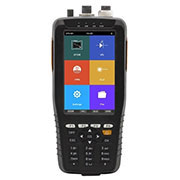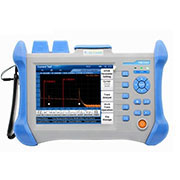How to Use an OTDR?
Optical fiber communication technology has developed rapidly in the last 20 years. Since optical fiber communication transmits a large amount of information at a fast speed, and it can transmits digital signals, which makes it possible to transmit information such as broadband image signals and computer networking. Thus, optical fiber measurement has entered into a new period of digitization.
The measurement of optical fiber loss is very important, it is directly related to the quality of optical fiber communication, and can detect possible fault points in time.
Parameter Setting
When connecting the test pigtail with an optical time domain reflectometer (OTDR), first clean the test side pigtail, then insert the pigtail into the vertical instrument test jack, and dent the raised U-shaped part of the pigtail and the test socket back to U. The type part is fully connected and properly tightened. When the line is repaired or cutover, before the fiber under test is connected to the OTDR, the maintenance personnel of the central office station at the opposite end of the hop should be notified to remove the corresponding connection pigtail on the fiber distribution box to avoid damage to the optical disc.
 Most OTDRs automatically select the best acquisition parameters by transmitting test pulses on the fiber to be tested. Users only need to select the wavelength, acquisition time and necessary fiber parameters (such as refractive index, scattering coefficient, etc.). It takes a certain amount of time to automatically acquire the parameters, therefore, under the known measurement conditions, the operator can manually select the measurement parameters.
Most OTDRs automatically select the best acquisition parameters by transmitting test pulses on the fiber to be tested. Users only need to select the wavelength, acquisition time and necessary fiber parameters (such as refractive index, scattering coefficient, etc.). It takes a certain amount of time to automatically acquire the parameters, therefore, under the known measurement conditions, the operator can manually select the measurement parameters.
- Wavelength selection: The behavior of the optical system is directly related to the transmission wavelength. Different wavelengths have different fiber attenuation characteristics and different behaviors in the fiber connection: the same fiber, 1550nm is more sensitive to bending than 1310nm fiber, 1550nm than 1310nm unit length attenuation is smaller, 1310nm measured higher splice or connector losses than 1550nm. To this end, the fiber test should be the same wavelength as the system transmits, which means that the 1550nm optical system needs to choose a wavelength of 1550nm.
- Pulse width: The pulse width controls the optical power injected into the optical fiber by the OTDR. The longer the pulse width, the larger the dynamic measurement range, which can be used to measure the optical fiber with longer distances, but the long pulse will also produce a larger dead zone in the OTDR curve waveform; the short pulse injected into the optical level Low, but can reduce the dead zone. The pulse width period is usually expressed in ns.
- Measuring range: The OTDR measurement range refers to the maximum distance that the OTDR obtains data sampling. The selection of this parameter determines the sampling resolution. The measurement range is usually set to be between 1 and 2 times the length of the fiber to be measured.

- Average time: Since the backscattered light signal is extremely weak, a statistical averaging method is generally used to improve the signal-to-noise ratio. The longer the averaging time, the higher the signal-to-noise ratio. For example, a 3min acquisition will increase the dynamics by 0.8dB over a 1min acquisition. But the acquisition time of more than 10min did not improve the signal-to-noise ratio much. Generally, the average time does not exceed 3min.
- Optical fiber parameters: The settings of the fiber parameters include the settings of the refractive index n and the backscattering coefficient η. Refractive index parameters are related to distance measurements, while backscatter coefficients affect reflection and return loss measurements. These two parameters are usually given by the fiber optic manufacturer.
After the parameters are set, the OTDR can send optical pulses and receive the light scattered and reflected by the optical fiber link, sample the output of the photodetector, obtain the OTDR curve, and analyze the curve to understand the fiber quality.
Safety Precautions of OTDR
- The OTDR will emit high-energy light signals when it is working, so it is forbidden to look directly at the port with your eyes during the test to avoid eye burns.

- Keep the OTDR test port and the optical port of the optical cable clean to avoid the phenomenon that there is no data in the test, that is, the optical link cannot work normally or the attenuation test is inaccurate.
- The OTDR test port has a built-in ceramic core, which is very fragile, so avoid vigorous twisting and bumping.
- During the OTDR test process, signals other than the signal emitted by the instrument are not allowed. First, it will interfere with the accuracy of the test, and second, it will damage the optical link equipment.
- Select the appropriate test distance and pulse width. If you don’t know the length of the optical cable, you can use the automatic test function of the instrument to get a general understanding of the quality of the optical cable to be tested, and then manually set the reasonable test range and pulse width and other parameters. It is used to precisely locate the position and loss of the entire fiber optic cable and its components.

